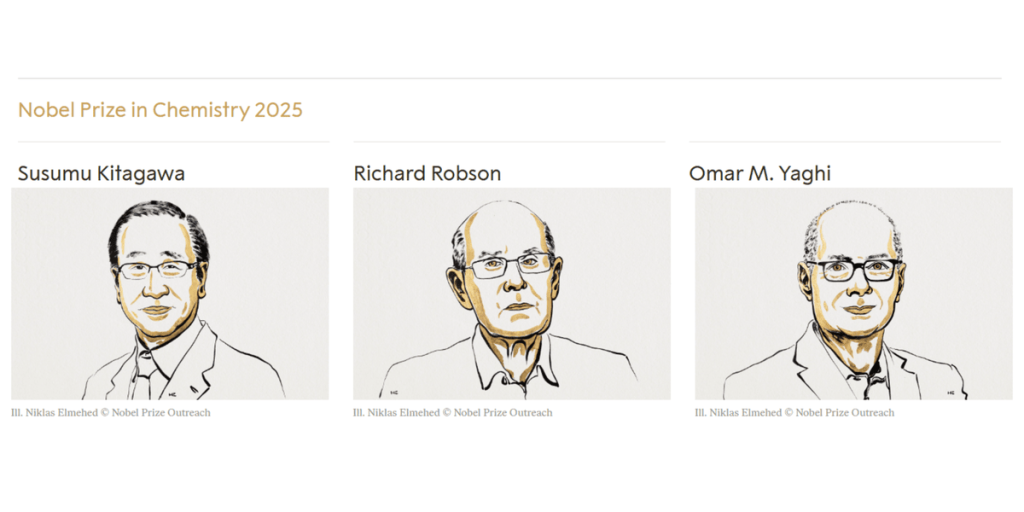The Royal Swedish Academy of Sciences has awarded the Nobel Prize in Chemistry 2025 to three trailblazing scientists — Susumu Kitagawa, Richard Robson, and Omar M. Yaghi — for their groundbreaking work in developing metal–organic frameworks (MOFs) [1]. These crystalline materials, composed of metal ions linked by organic molecules, contain vast, customizable cavities that can store, filter, and transform substances with remarkable precision.
Transforming Materials Science
MOFs represent a new kind of molecular architecture. By combining metal ions, which act as structural “cornerstones,” with long carbon-based molecules, the laureates created structures capable of capturing gases, filtering harmful compounds, storing toxic substances, and even driving chemical reactions. This modular design means chemists can tailor MOFs to specific tasks, making them highly versatile in both environmental and industrial applications.
The Laureates
- Susumu Kitagawa (born 1951, Kyoto, Japan) — PhD 1979, Kyoto University; Professor at Kyoto University.
- Richard Robson (born 1937, Glusburn, UK) — PhD 1962, University of Oxford; Professor at University of Melbourne.
- Omar M. Yaghi (born 1965, Amman, Jordan) — PhD 1990, University of Illinois Urbana-Champaign; Professor at University of California, Berkeley.
The trio will share the prize amount of 11 million Swedish kronor equally, marking a milestone in the field of chemistry and the science of materials.
Visit TOPSCINET to explore detailed profiles of the Nobel Prize laureates and learn more about their groundbreaking contributions: https://topscinet.com/nobel/
From Concept to Breakthrough
The journey began in 1989 when Richard Robson demonstrated how copper ions and a specially designed four-armed molecule could form spacious, orderly crystals — akin to diamonds filled with empty chambers. Though his early MOFs were unstable, his discovery paved the way for further innovations.
Between 1992 and 2003, Susumu Kitagawa and Omar M. Yaghi independently made key advances:
- Kitagawa proved that gases could move in and out of MOFs and predicted their flexibility.
- Yaghi produced exceptionally stable MOFs and pioneered rational design methods to give them tailored properties.
Addressing Global Challenges
Tens of thousands of MOFs have been synthesized since these breakthroughs. Their potential is vast and includes:
- Capturing carbon dioxide to mitigate climate change
- Harvesting water from desert air
- Removing persistent pollutants like PFAS from drinking water
- Breaking down pharmaceutical residues in the environment
With such capabilities, MOFs may soon play a critical role in solving some of humanity’s most pressing problems.
References:
[1] https://www.nobelprize.org/all-nobel-prizes-2025/
[2] https://www.nobelprize.org/prizes/chemistry/2025/press-release
Searchable Database for Top 2% Scientists
Visit TOPSCINET.com
If your name appears in the search results, claim your profile using your institutional email to update your social media links and enhance your online presence.




